
Thomas Oommen. Photo by Thomas Graning/Ole Miss Digital Imaging Services
Geological engineering professor to provide guidance on mine waste monitoring, safety
A University of Mississippi professor has begun studying the impact of mining waste structures as part of a national initiative to improve disaster readiness.
The U.S. Department of Commerce‘s National Institute of Standards and Technology and the National Science Foundation have awarded more than $7 million in grants to support natural hazard preparedness to 15 universities across the nation, including Ole Miss.
Each university will tackle an aspect of disaster readiness, from how to build structures that can survive storm wave impacts to creating damage prediction models for earthquakes, fires and floods.
The Disaster Resilience Research Grant allotted nearly $400,000 to Thomas Oommen, UM chair and professor of geology and geological engineering, and Sidike Paheding, assistant professor of computer science at Fairfield University, to study mine tailing impoundments, massive structures that store mining waste.
“With the increased interest in green energy and battery technology, the need for critical minerals and mining is increasing,” Oommen said. “That means mine tailings are going to be more and more prevalent, but monitoring these dams is a challenge.”
Mining operations leave behind massive amounts of slurry, or solid waste, that is stored behind dams constructed of the same waste material, Oommen said. While some of the materials are harmless – such as rock, sediment and other debris – others are toxic, including arsenic, lead, uranium, and other compounds.
When these dams fail, a flood of waste has been known to reach more than 6 miles from the dam site, Oommen said. A dam in Brumadinho, Brazil, failed in 2019, sending a wall of waste and mud into a small town more than half a mile away, killing more than 240 people.
“Mine tailings dams are really large geotechnical, earthen structures, and they’re prone to failure with extreme weather events,” Oommen said. “The consequences of failure can be catastrophic both in terms of casualties and environmental effects.”
Similar failures have happened in Mississippi. In 2005, a phosphate mine tailings dam failure allowed more than 17 million gallons of acidic liquid to pour into surrounding marshland, killing vegetation near Bangs Lake in Jackson County.
Some 12,563 mines are active across the United States, but there is no rough count of how many mine tailings dams exist. When mines shut down, oversight of the impoundments often becomes lax, Oommen said.
“The challenge is when the mining operation is happening, there is a lot of interest in the dam and its upkeep, but once the operation is done and there is no more revenue being generated, the companies are gone,” he said. “So, who is going to maintain this? Often, it becomes no one’s property or it falls into the hands of the government to maintain it.
“So, maintaining and monitoring these tailings dams is a challenge, especially if you have to do it manually, using traditional methods.”
Oommen and Paheding’s research will use satellite and environmental data to detect whether a dam is at risk of failure. They will also use historical weather records to determine what correlation, if any, there is between hazardous weather and dam failures.
“We need to prevent environmental damage, especially if there are residents living in nearby areas,” Paheding said. “Our goal is to provide a technological solution to prevent these incidents.”
Using satellite imagery and environmental data, Paheding and Oommen hope to develop an advanced machine learning model that can identify potential issues, Paheding said.
If successful, the technology would allow remote monitoring of mine tailing impoundments and help predict when a dam is becoming unstable, Oommen said.
“From my perspective, I hope we can have a sophisticated algorithm that can be utilized to solve this problem,” Paheding said. “We don’t want have something that works in theory; we want to have something applicable in a real-world scenario.”
This material is based upon work supported by the National Science Foundation under grant No. 2414588.
By Clara Turnage





